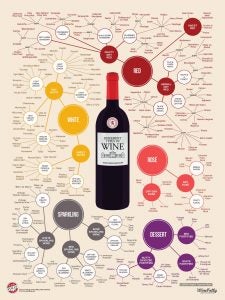The wine industry in America was worth $220 billion in 2017, according to Wine Spectator, and Zion Market Research expects the global wine market to reach $423.59 billion by the year 2023. Bottles upon bottles line grocery store shelves, wine-related events are held all over the country throughout the year, and wineries total 7,762 in the U.S., according to Wines & Vines Magazine. With an industry this large, it seems imperative that agriculture enthusiasts have a basic knowledge of wine.
This can prove challenging, however. If you spend any time with friends who are wine-drinkers, you might get lost in their parlance. There is an entire wine-culture that entails knowing whether a wine is dry or sweet, what foods it pairs well with, and how to wine-taste like an expert. So, where does one start on their journey to becoming a wine pro?
First, be aware that wine grapes are different than the table grapes you buy at grocery stores. In fact, the grapes you buy to eat are probably a different species from grapes used to make wine. Vitis Vitifera is a wine specie that originates from the Mediterranean, Europe, and the Middle East. While some table grapes are this specie as well, they are more commonly Vitis Labrusca, and Vitis Rotundifolia.
A few other differences include their skin thickness, sweetness, size, and yield. According to Vine Pair, table grapes have thinner skins compared to their wine counterparts. Some exceptions include Pinot Noir grapes, whose skins are thin, making them more difficult to bring to ripeness and require them to grow in cooler climates. Typically, though, the grapes used to create wine have thicker skins to help impart tannins and bring rich color. Tannins — which come from the skin, seed and stalks — are a what give wine the sensation of dryness or astringency. If you want to learn about tannins in more detail, follow this link.
When it comes to taste, wine grapes are sweeter and smaller in size. According to Vine Pair, “That’s a necessary thing because grapes need a lot of sugar if yeast is going to convert their juices into alcohol. Higher sweetness comes from the species itself, along with the fact that wine grapes are harvested much later in the season than grapes meant for the table, allowing their sugars to concentrate as much as possible. Wine grapes are harvested at around 22-30 percent sugar while table grapes might be closer to 10 or 15 percent sugar. This also means wine grapes deteriorate much faster when picked than grapes meant for the table.” They also need to be smaller in order to have concentrated flavor, and retain less water.
Perhaps the biggest difference to farmers is the difference in yield. Table grapes are typically on a trellis system that allows about 30 pounds of fruit to be produced. This much production with wine grapes isn’t ideal for wine-making. Less than 10 pounds per vine of fruit is more common for wine grapes.
Once you have the basic differences down, it’s time to look into which grapes make which wines. Vine Pair compiled a list of the most common varieties you’ll find throughout the world, which includes different types, from Merlot to Chenin Blanc, and what wines they make. However, there are over 10,000 kinds of wine grapes in the world, according to Winestyr. These can include blends of varietals which make different styles(more on that later). The regions from which they come have the biggest influence on the flavor. There are both red and white grape varieties, which each make their respective kind of wine. However, underneath these two kinds, there are thousands of types. The most common premium varieties are:
- Barbera
- Carménère
- Chianti
- Grenache
- Moscato
- Petite Sirah
- Riesling
- Sauvignon Blanc
- Blaufränkisch
- Cabernet Franc
- Chardonnay
- Gamay
- Grüner Veltliner
- Malbec
- Pinot Grigio / Gris
- Rosé Wine
- Syrah & Shiraz
- Zinfandel, Both Red & White
- Cabernet Sauvignon
- Chenin Blanc
- Gewürztraminer
- Merlot
- Nebbiolo
- Pinot Noir
- Rioja
- Sparkling Wines

This infographic, by Wine Folly, visually explains what kind of wine each variety of grape creates. Each of these grapes make a wine that has a unique style to them. Style refers to a combination of color, taste, alcoholic strength, and other factors. To help break it down for you, The Wine Society has a guide to determine which wine fits your palate, based upon it’s style. The nine major categories of style, as found on Wine Folly, are:
- Sparkling Wine
- Light-Bodied White Wine
- Full-Bodied White Wine
- Aromatic (sweet) White Wine
- Rosé Wine
- Light-Bodied Red Wine
- Medium-Bodied Red Wine
- Full-Bodied Red Wine
- Dessert Wine
Now that you have basic grasp on types of wine and grapes used to make that type, it’s also important to know the process in making those wines.
It all begins with harvesting at the right time so they are fresh and fully ripened. Then, they are crushed — removing stems and allowing color-extract. Following this step, is juice separating, must treatment, and then fermentation.
Alcoholic Fermentation is a process, detailed by the University of Utah, “that requires suppression of the growth of undesirable microorganism, presence of adequate numbers of desirable yeasts, proper nutrition for yeast growth, temperature control for prevention of excessive heat, and prevention of oxidation.” The final process in wine making is clarification, which involves fining, filtration, centrifugation, and refrigeration.
Once wine is bottled and ready to be enjoyed, there is also a set of rules in serving and tasting wine! Vine Pair has your go-to guide on which kinds of glasses to serve your wine in, how to swirl and smell your wine before tasting, and what wine legs are. Hint: they are the droplets or streaks of water that form on the inside of a wine glass as you move the wine around.
Markie Hageman majored in agribusiness at Fort Hays State University. She is actively involved in her state Cattlemen’s Association, Young Farmers chapter, and National Cattlemen’s Beef Association. Her AGDAILY.com articles can be found here.



